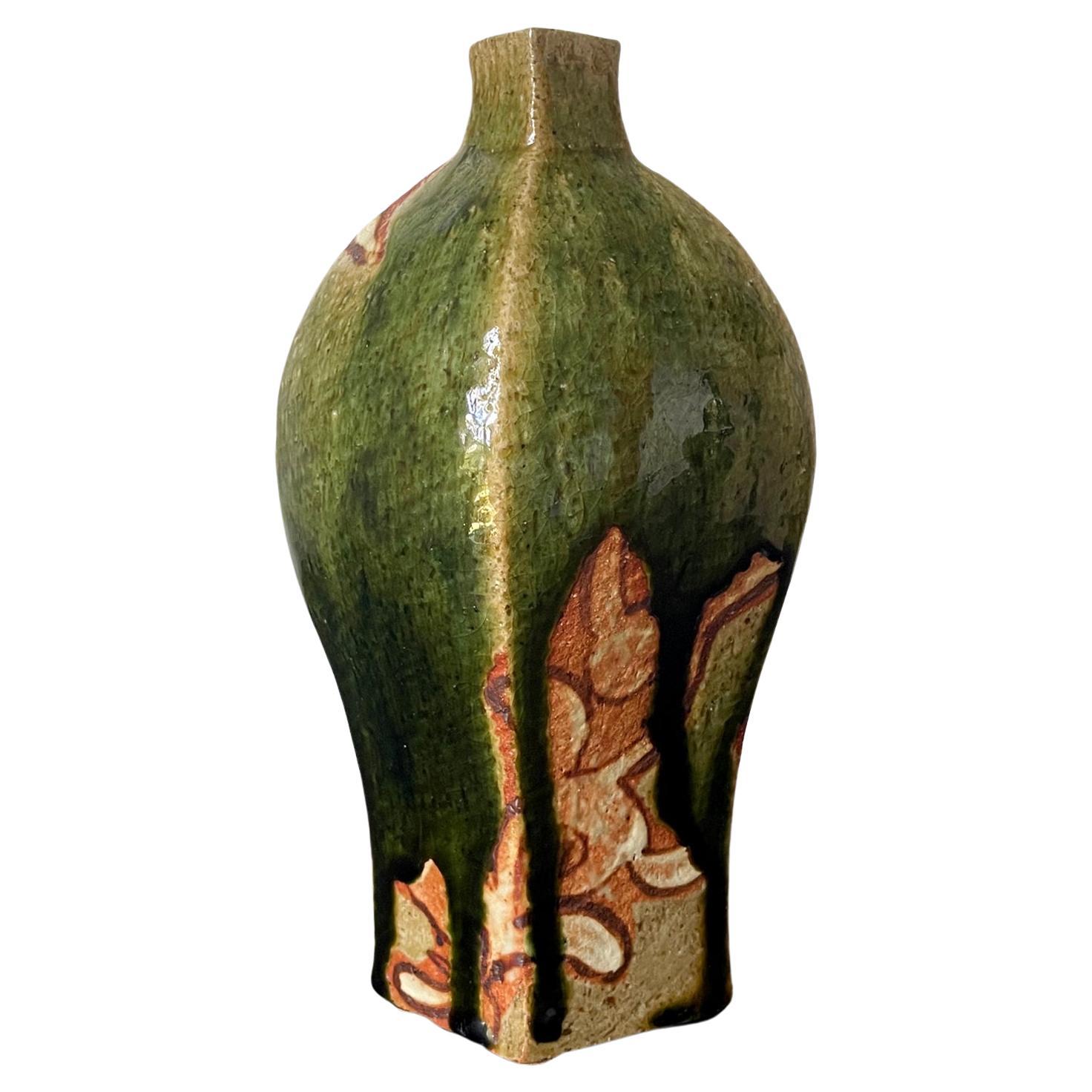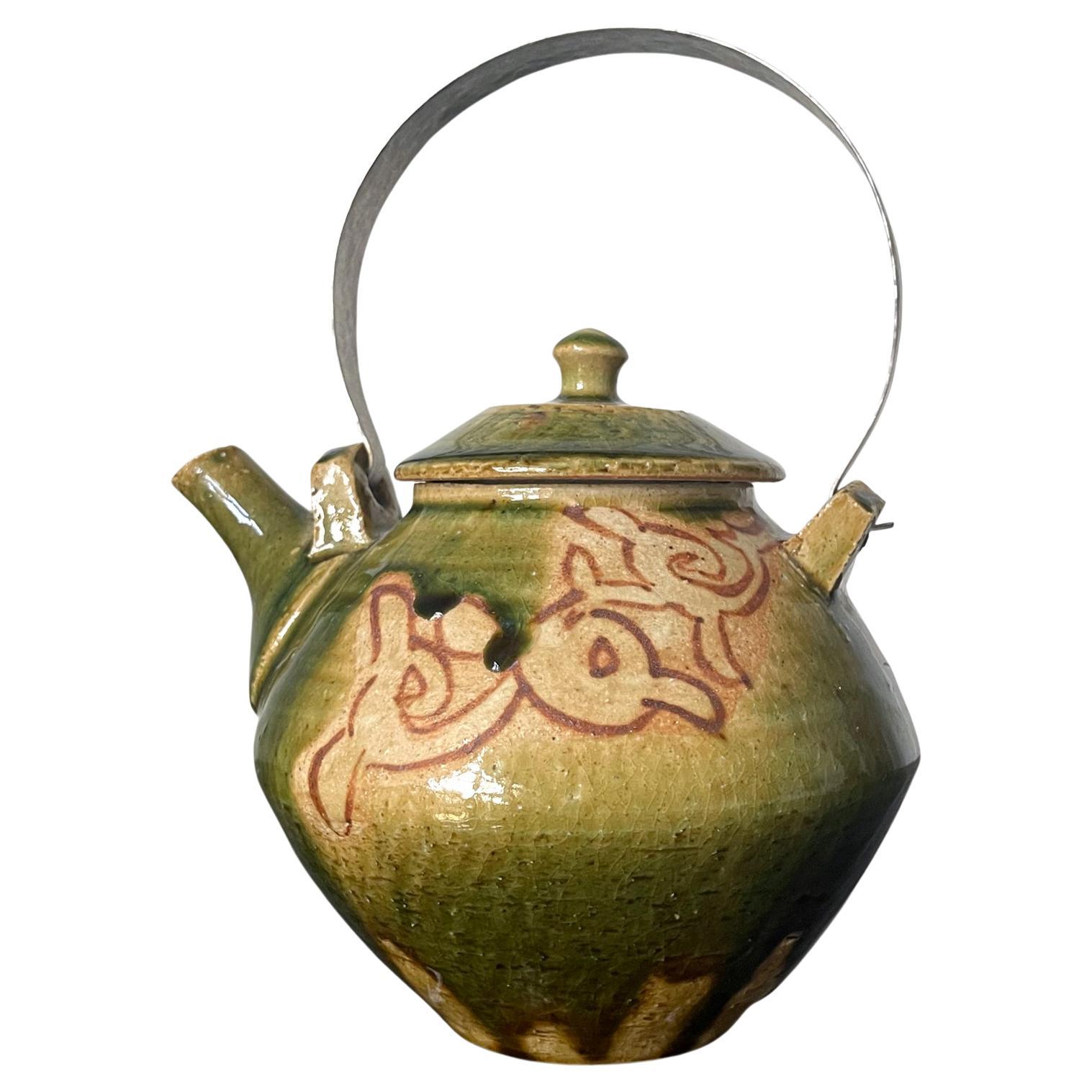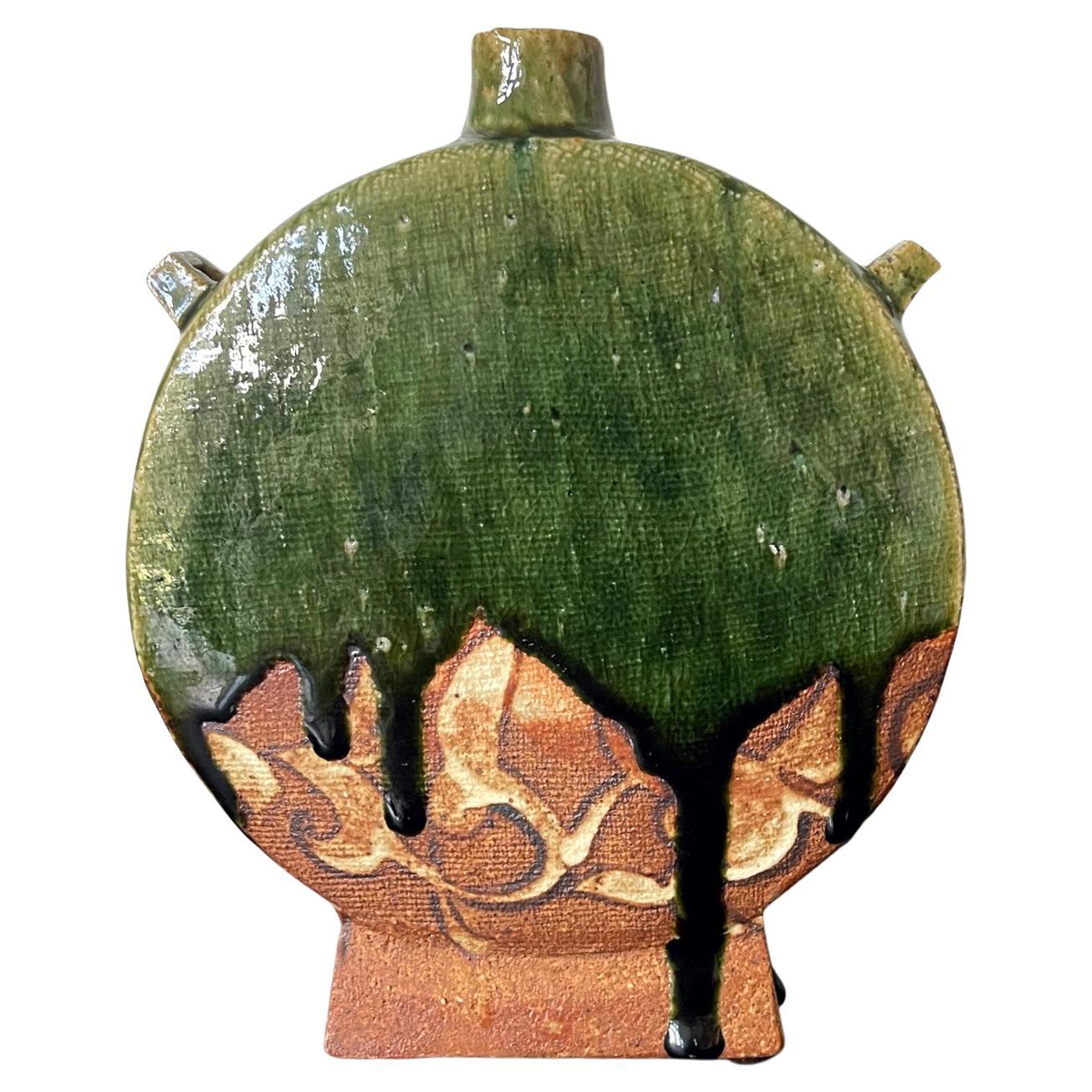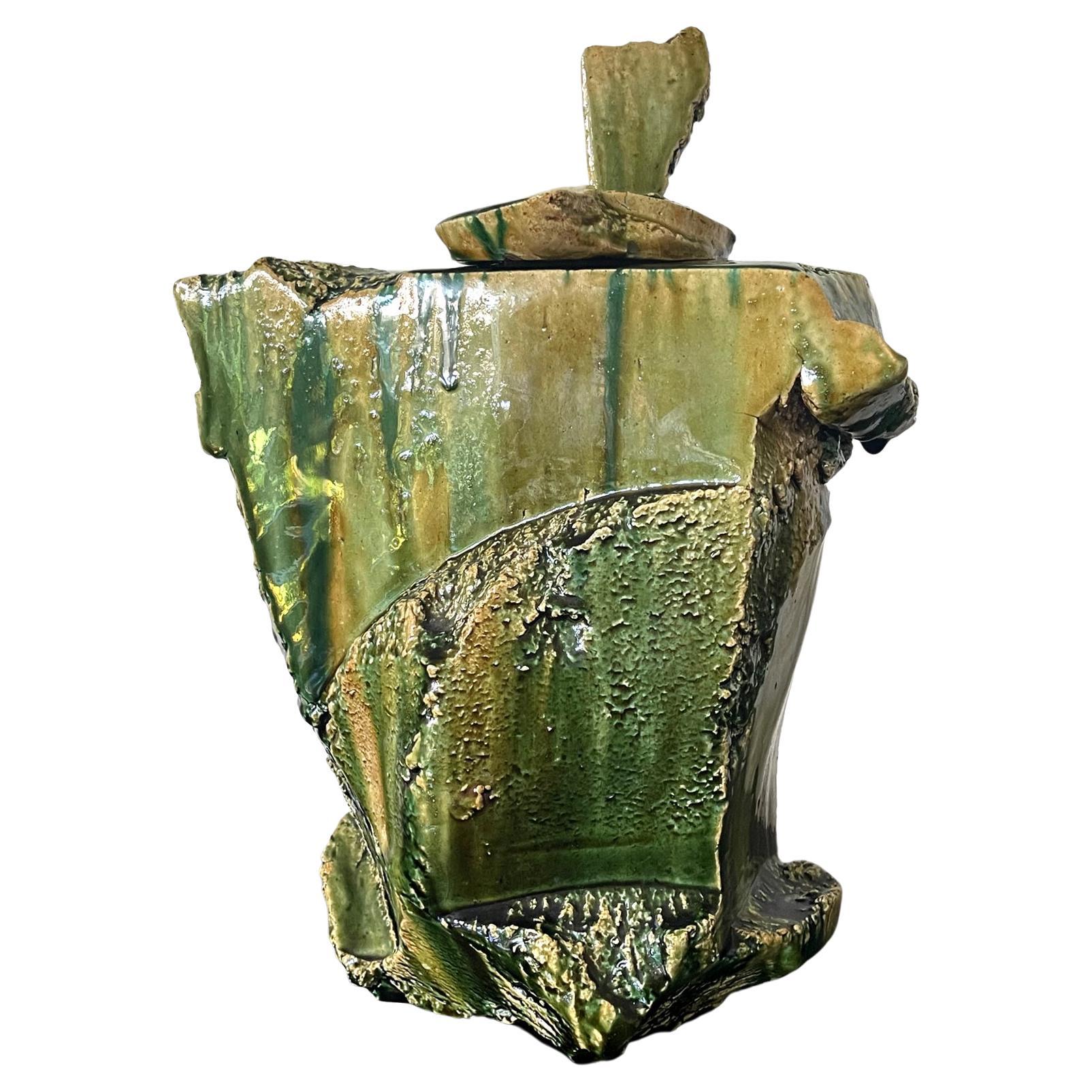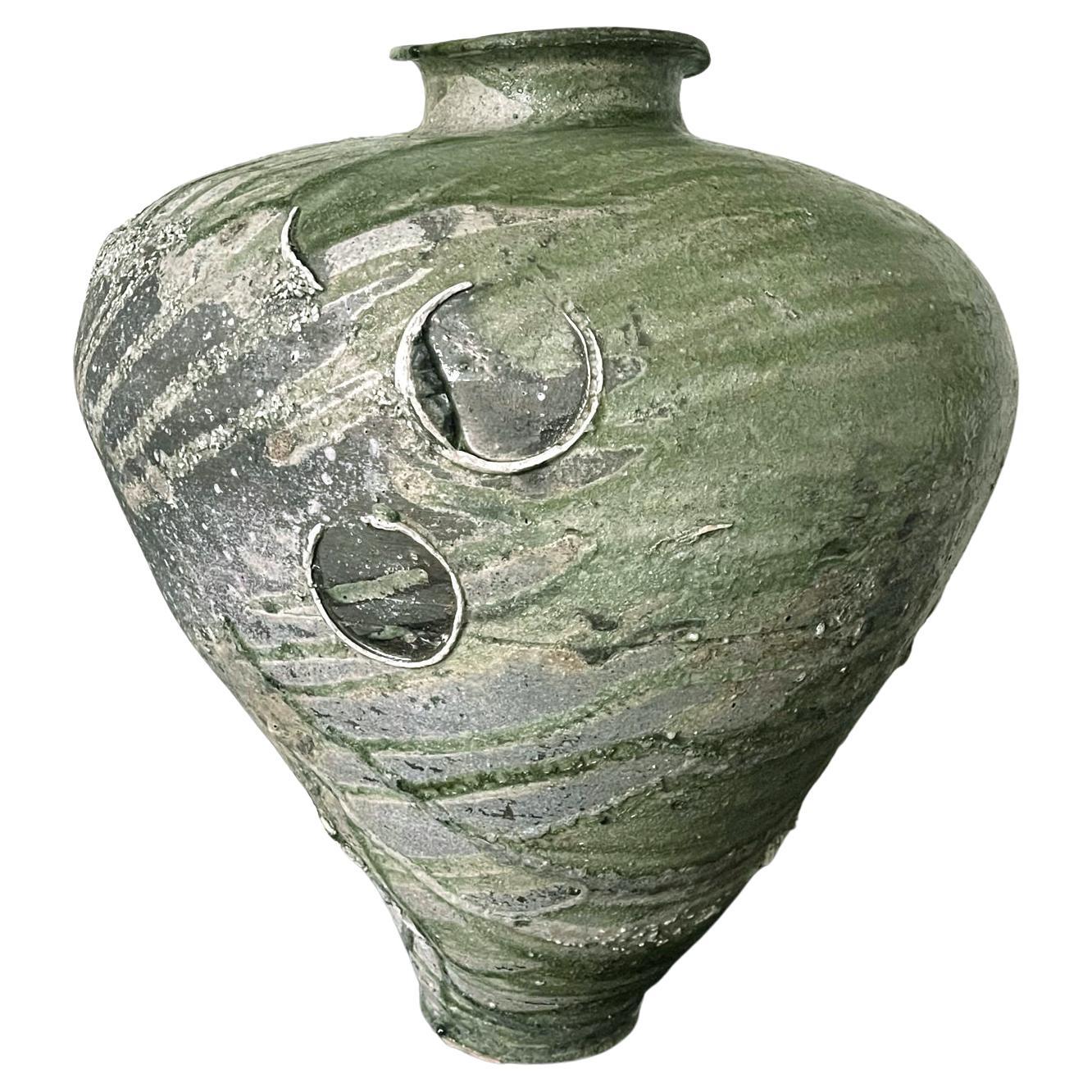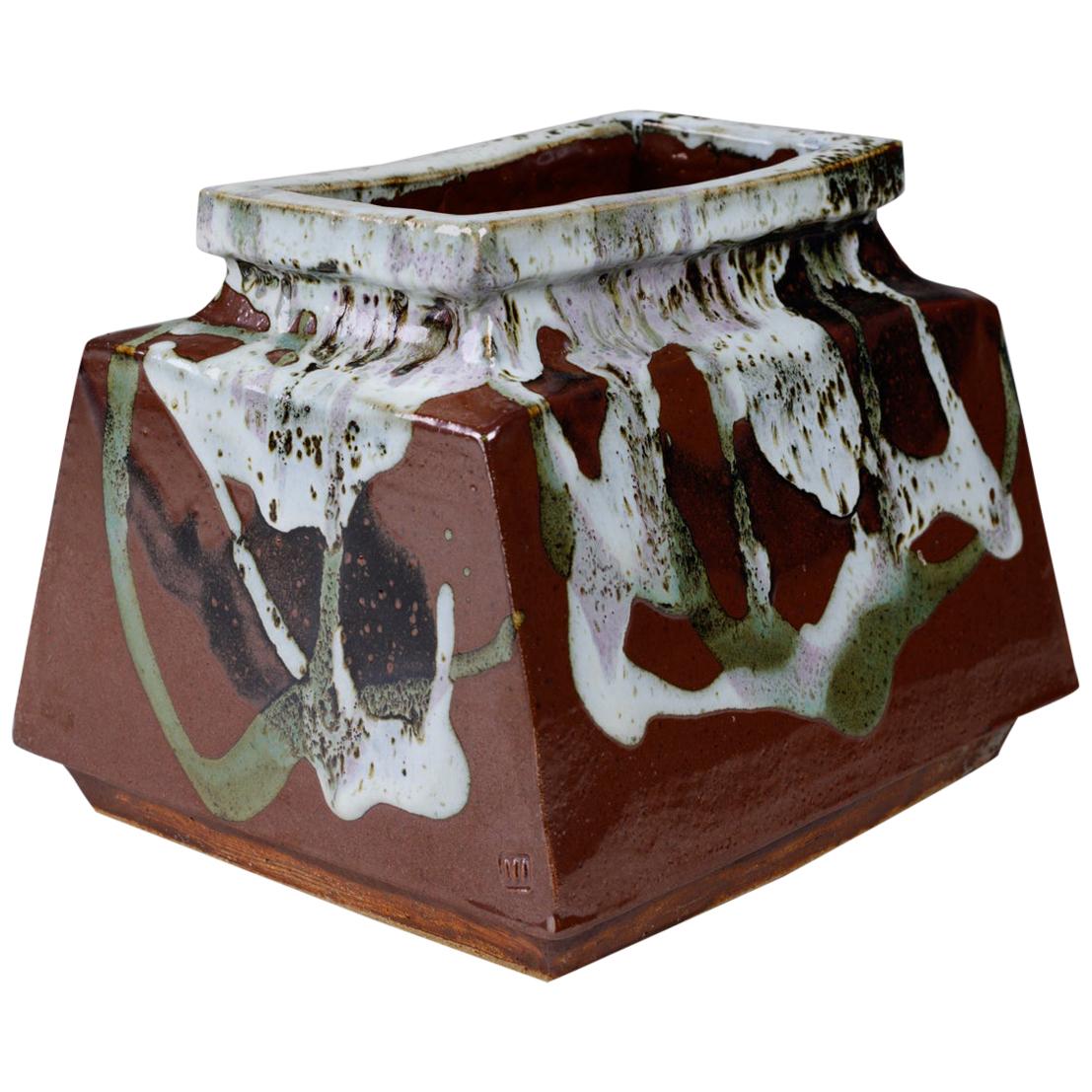Items Similar to Japanese Modern Studio Ceramic Oribe Jar by Ryoji Koie
Want more images or videos?
Request additional images or videos from the seller
1 of 19
Japanese Modern Studio Ceramic Oribe Jar by Ryoji Koie
About the Item
A glazed ceramic vessel by Japanese potter Ryoji Koie (1938-2020). Hand-built with intention to be seen as such, the tsubo has a primordial irregular form with a small opening and a swelled body resembling a beehive. The upper body was covered in a glassy green oribe glaze with fine crackles, highlighted with three incised geometrical symbols. The lower body is unglazed and exposed the white clay with marks of the hand-making pinches and kneading along the base. The base also shows highly irregular surface due to the seashell spur marks and clay pitting in the kiln during the firing process. All these occurrences honestly preserved and presented as part of the character of this wonderful modern piece. The jar comes with a plain wooden tomobako box.
"One of Japan’s most versatile and forward-thinking contemporary artists, KOIE RYOJI was best known as a ceramist but esteemed for his two-dimensional artwork as well. His love of experimentation led to his creation of “ceramic happenings,” with themes that were social and often political critiques of the horrors of the 20th century. Born in 1938 in Tokoname, one of the oldest ceramic centers in Japan, Koie studied ceramics locally but almost immediately developed his iconoclastic style. Rather than labor to preserve tradition, as a young man, he looked to movements in postwar contemporary art such as the abstract expressionist paintings of Jackson Pollock and the found-object ethos of Mono-ha. The gestural application of glazes on his ceramics created dynamic surfaces that reflected this innovative approach. His works can be found in the permanent collections of prominent museums on five continents."
Courtesy from Joan B. Mirviss LTD.
- Creator:Ryoji Koie (Artist)
- Dimensions:Height: 8 in (20.32 cm)Diameter: 8 in (20.32 cm)
- Style:Modern (Of the Period)
- Materials and Techniques:Ceramic,Glazed
- Place of Origin:
- Period:
- Date of Manufacture:2000s
- Condition:Wear consistent with age and use. Fine condition, some intended glaze dripping from making process. Base as shown not chipped but made as it is.
- Seller Location:Atlanta, GA
- Reference Number:1stDibs: LU945028780682
About the Seller
5.0
Platinum Seller
These expertly vetted sellers are 1stDibs' most experienced sellers and are rated highest by our customers.
Established in 2006
1stDibs seller since 2010
479 sales on 1stDibs
Typical response time: <1 hour
- ShippingRetrieving quote...Ships From: Atlanta, GA
- Return PolicyA return for this item may be initiated within 2 days of delivery.
More From This SellerView All
- Modern Japanese Studio Pottery Oribe Vase by Ken MatsuzakiBy Ken MatsuzakiLocated in Atlanta, GAA contemporary studio ceramic vase made by Japanese potter Ken Matsuzaki (1950-). The vase showcases a geometrical spindle form, rather distinguishingly modern. It is covered with a thick dripping Oribe green glaze partially revealing the unglazed part of the body, which is decorated with scrolling pattern in left by ash glaze. The work is rooted in both Yohen Shino glaze technique and Oribe tradition, but it is an innovative reinterpretation of the ancient aesthetic. The base is marked with the artist's signature. The vase comes with an inscribed tomobako storage box with the artist's bio and wrapping cloth with seal. The vase measures 9"h x 5.5"w x 4"d. Ken Matsuzaki’s haptic ceramics bring a contemporary approach to traditional Japanese ceramicware, most notably 16th-century Oribe pottery...Category
Early 2000s Japanese Modern Ceramics
MaterialsCeramic
- Modern Japanese Studio Pottery Oribe Tea Pot by Ken MatsuzakiBy Ken MatsuzakiLocated in Atlanta, GAA contemporary studio ceramic tea pot with metal handle made by Japanese potter Ken Matsuzaki (1950-). The stoneware tea pot showcases a thick dripping Oribe green glaze partially revealing the unglazed part of the body, which is decorated with scrolling pattern of ash glaze. The work is rooted in both Yohen Shino glaze technique and Oribe tradition, but interestingly it also paid homage to Sancai pottery...Category
Early 2000s Japanese Modern Ceramics
MaterialsCeramic
- Modern Japanese Studio Pottery Oribe Moon Flask Vase by Ken MatsuzakiBy Ken MatsuzakiLocated in Atlanta, GAA contemporary studio ceramic vase made by Japanese potter Ken Matsuzaki (1950-). The vase showcases distinguished "moon flask" form with shoulder loops. The moon flask form was widely recorded first in Tang Dynasty China, most likely arrived from the Mideast countries via the silk road. It was originally used as drink vessel for the nomads and the loops were used to tie it to the horse-centered owner. The exotic form persisted in Chinese ceramic production through Ming to Qing dynasty. The form is unusual in Ken Matsuzaki's work. The artist covered the vase with a thick dripping Oribe green glaze partially revealing the unglazed part of the body, which is decorated with scrolling pattern in left by ash glaze. The work is rooted in both Yohen Shino glaze technique and Oribe tradition, but interestingly it also paid homage to Sancai pottery in Tang Dynasty when green glaze was prominently used to drip and splash onto the pottery. Viewing the vase, one can see in this harmonious piece, the innovative reinterpretation of ancient aesthetics that cross the cultures, geology and time. The base is marked with the artist's signature. The vase comes with an inscribed tomobako storage box with the artist's bio and wrapping cloth with seal. The vase measures 8.6"h x 7"w x 2"d. Ken Matsuzaki’s haptic ceramics bring a contemporary approach to traditional Japanese ceramicware, most notably 16th-century Oribe pottery...Category
Early 2000s Japanese Modern Ceramics
MaterialsCeramic
- Large Japanese Ceramic Oribe Sculptural Vessel by Shigemasa HigashidaLocated in Atlanta, GAA large ceramic lidded vessel with striking sculptural form by contemporary Japanese potter Shigemasa Higashida (1955-). Hand-built and with drasti...Category
Early 2000s Japanese Modern Ceramics
MaterialsCeramic
- Massive Ceramic Jar Tsubo by Japanese Potter Tsujimura YuiBy Tsujimura YuiLocated in Atlanta, GAA massive and magnificent ceramic Tsubo jar by Japanese potter Tsujimura Yui (1975-). Inspired by the techniques and aesthetics of the early medieval Sue ware, the artist hand builds an impressive voluminous oviform, irregular by intention, from a combination clay from both Shigaraki and Iga, coarse by nature and rich in feldspar. Fired on their sides horizontally, the surface of the thick wall tsubo is covered with streaks and drips of natural ash glazes in shades of green and blue, forming an abstract and mesmerizing pattern that resembles geothermal earth activity. Additional ashes are blown during the firing to accentuate the textures. Most recognizably, there are many circular marks scattered on the surface of his archaic looking vessels. That is resulted from using stacked tea bowls to prevent the conjoining of the vessels. After the firing, the stacked vessels are chipped away, leaving behind those circular impression, as well as deep pools of glaze which gather where they were placed. Born in 1975, Tsujimura Yui is the first son of the contemporary ceramic artist Tsujimura Shiro...Category
Early 2000s Japanese Modern Ceramics
MaterialsCeramic
- Japanese Studio Ceramic Vase by Ken Matsuzaki with Original TomobakoBy Ken MatsuzakiLocated in Atlanta, GAAn impressive stoneware bottle form vase by contemporary Japanese studio potter Ken Matsuzaki (1950-) circa 2010s. The solid form takes its cue from Chinese traditional plum vase (Meiping) with raised and swelled shoulder and a small opening, yet it rises from a non-conventional pentagonal faceted base. The extraordinary surface was covered with Yohen Shino glaze in a deep iron hue. Thick white slips were applied in bold strokes to the lower portion of the vase. The abstract pattern calls to mind of the imagery of the iconic ocean waves found in traditional Japanese art. The presence of the vase is strong and none-compromising, reaching back to the past yet appearing utterly modern. It is marked by the artist underneath and comes with the original tomobako with title and author inscriptions and a wrapping cloth with the artist's seal. "Ken Matsuzaki’s haptic ceramics bring a contemporary approach to traditional Japanese ceramicware, most notably 16th-century Oribe pottery...Category
21st Century and Contemporary Japanese Modern Ceramics
MaterialsCeramic
You May Also Like
- Modern Japanese Ceramic VaseLocated in Hudson, NYModern Japanese ceramic vase, the title of this piece is "Kaki yu" or "Persimmon glaze". Rectangular vase, with abstract design and heavy glazin...Category
Vintage 1970s Japanese Showa Ceramics
MaterialsCeramic
- Mid Century Japanese Studio Ceramic VaseLocated in New York, NYA vintage Japanese studio ceramic potter vase in mint green with white. 4606Category
20th Century Japanese Ceramics
MaterialsCeramic
- Japanese Mid-Century Modern Studio Pottery VaseLocated in New York, NYJapanese Mid-Century Modern art studio pottery vase with luster glaze on diminutive tripod legs.Category
Mid-20th Century Japanese Mid-Century Modern Ceramics
MaterialsPottery
- Antique Ceramic Food JarsLocated in New York, NYLarge antique ceramic food jars with beautifully rendered bird and floral imagery. From China, Hebei Province, circa 1900.
CR430CategoryEarly 20th Century Chinese Ceramics
MaterialsCeramic
- Antique Japanese Awaji Burgundy JarsLocated in Malibu, CAThese antique Awaji jars have a deep burgundy color with a beautiful translucence created by such high temperatures during firing, that it borders on stoneware. The interior brush ma...Category
Early 20th Century Japanese Anglo-Japanese Ceramics
MaterialsPottery
- Japanese Red Gold Mizusashi Jar by Master Porcelain ArtistLocated in Takarazuka, JPExquisite Japanese contemporary jar/mizusashi, extremely intricately hand painted in red, green and blue and gilded with pure gold featuring seasonal panels showing children at play ...Category
21st Century and Contemporary Japanese Jars
MaterialsGold
Recently Viewed
View AllMore Ways To Browse
Japanese Furniture Modern
Japanese Modern
Japan Modern
Modern Japanese
Modern Studio Ceramics
Ceramic Japan
Art By Well Known Artists
Ceramics From Japan
Japanese 20th Century Modern Furniture
Japanese Glazed Ceramic
Japanese Symbol
Postwar Modern
Japanese Modern Ceramics
Used Ceramics Kilns
Modern Japan Ceramic
Man Ceramic
Japanese Small Box
Japanese White Ceramic
